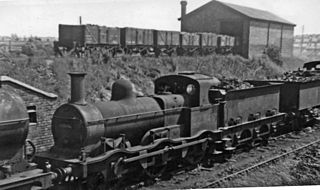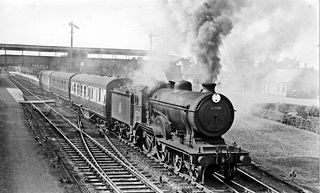The LMS Turbomotive was a modified LMS Princess Royal Class steam turbine locomotive designed by William Stanier and built by the London, Midland and Scottish Railway in 1935. It was inspired by the Swedish Ljungström locomotives first introduced in 1922. It used turbines instead of cylinders. It was later rebuilt as a conventional locomotive No. 46202 Princess Anne.

The London, Midland and Scottish Railway (LMS) Jubilee Class is a class of steam locomotive designed for main line passenger work. 191 locomotives were built between 1934 and 1936. They were built concurrently with the similar looking LMS Stanier Class 5 4-6-0. They were nicknamed Red Staniers and Jubs.

The London, Midland and Scottish Railway Fowler Class 7F was a class of 0-8-0 steam locomotives. They were a Midlandised version of the London and North Western Railway (LNWR) Class G2 and Class G2A 0-8-0s. They were also classified as Class G3 under the former LNWR system. The class were sometimes known as Baby Austins, or Austin 7s, after a motor car that was becoming popular at the time.

The London, Midland and Scottish Railway (LMS) Stanier Class 5 4-6-0, commonly known as the Black Five, is a class of 4-6-0 steam locomotives. It was introduced by William Stanier and built between 1934 and 1951, of which 842 were built and were numbered 4658-5499. Several members of the class survived to the last day of steam on British Railways in 1968, and eighteen are preserved.

The London, Midland and Scottish Railway (LMS) Stanier Class 8F is a class of steam locomotives designed for hauling heavy freight. 852 were built between 1935 and 1946, as a freight version of William Stanier's successful Black Five, and the class saw extensive service overseas during and after the Second World War.

The London, Midland and Scottish Railway (LMS) Royal Scot Class is a class of 4-6-0 express passenger locomotive introduced in 1927. Originally having parallel boilers, all members were later rebuilt with tapered type 2A boilers, and were in effect two classes.

The Patriot Class was a class of 52 express passenger steam locomotives built for the London Midland and Scottish Railway. The first locomotive of the class was built in 1930 and the last in 1934. The class was based on the chassis of the Royal Scot combined with the boiler from Large Claughtons earning them the nickname Baby Scots. A total of 18 were rebuilt to create the LMS Rebuilt Patriot Class between 1946 and 1948; thereafter those not subjected to rebuilding were often referred to as the Unrebuilt Patriot Class. These remaining 34 unrebuilt engines were withdrawn between 1960 and 1962.

The London, Midland and Scottish Railway (LMS) Hughes Crab or Horwich Mogul is a class of mixed-traffic 2-6-0 steam locomotive built between 1926 and 1932. They are noted for their appearance with large steeply-angled cylinders to accommodate a restricted loading gauge.

The Great Eastern Railway (GER) Class Y14 is a class of 0-6-0 steam locomotive. The LNER classified them J15.

The London Midland and Scottish Railway (LMS) Fowler Class 4F is a class of 0-6-0 steam locomotive designed for medium freight work. They represent the ultimate development of Midland Railway's six coupled tender engines. Many trainspotters knew them as "Duck Sixes", a nickname derived from their wheel arrangement.

The London, Midland and Scottish Railway Compound 4-4-0 was a class of steam locomotive designed for passenger work.

The Midland Railway (MR) 3835 Class is a class of 0-6-0 steam locomotives designed for freight work. The first two were introduced in 1911 by Henry Fowler. After the grouping in 1923, the designs were slightly modified and continued to be built up to 1941 by the LMS as the LMS Fowler Class 4F.

London, Midland and Scottish Railway (LMS) Royal Scot Class 6100Royal Scot is a preserved British steam locomotive.
The Midland Railway 1000 Class is a class of 4-4-0 steam locomotive designed for passenger work. They were known to reach speeds of up to 85 mph.

The Midland Railway 2000 Class was a class of 40 0-6-4T steam locomotives designed by Richard Deeley. They were known as "flatirons" or "hole-in-the-wall tanks" because of their distinctive shape; their side tanks extended to the front of the smokebox and they had a distinct cut-out in the side tanks to access the motion. They were numbered 2000–2039.

The Midland Railway 700 Class was a large class of double framed 0-6-0 freight steam locomotives designed by Matthew Kirtley for the Midland Railway. They were in the power classification 1F.

The GER Classes S46, D56 and H88 were three classes of similar 4-4-0 steam locomotive designed by James Holden and A. J. Hill (H88) for the Great Eastern Railway.

The London and North Western Railway (LNWR) Claughton Class was a class of 4-cylinder express passenger 4-6-0 steam locomotives.

The Caledonian Railway 721 Class was a class of 4-4-0 steam locomotives designed by John F. McIntosh for the Caledonian Railway (CR) and introduced in 1896. All survived to be absorbed by the London, Midland and Scottish Railway (LMS) in 1923 and a few survived into British Railways (BR) ownership in 1948.

The Caledonian Railway 49 Class and 903 Class were 4-6-0 express passenger locomotives designed by John F. McIntosh and built at the Caledonian Railway's own St. Rollox Works in 1903 and 1906 respectively.























